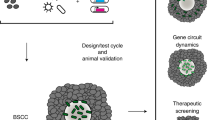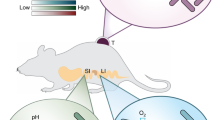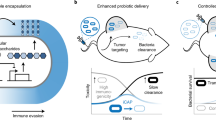Abstract
The widespread view of bacteria as strictly pathogenic has given way to an appreciation of the prevalence of some beneficial microbes within the human body1,2,3. It is perhaps inevitable that some bacteria would evolve to preferentially grow in environments that harbour disease and thus provide a natural platform for the development of engineered therapies4,5,6. Such therapies could benefit from bacteria that are programmed to limit bacterial growth while continually producing and releasing cytotoxic agents in situ7,8,9,10. Here we engineer a clinically relevant bacterium to lyse synchronously at a threshold population density and to release genetically encoded cargo. Following quorum lysis, a small number of surviving bacteria reseed the growing population, thus leading to pulsatile delivery cycles. We used microfluidic devices to characterize the engineered lysis strain and we demonstrate its potential as a drug delivery platform via co-culture with human cancer cells in vitro. As a proof of principle, we tracked the bacterial population dynamics in ectopic syngeneic colorectal tumours in mice via a luminescent reporter. The lysis strain exhibits pulsatile population dynamics in vivo, with mean bacterial luminescence that remained two orders of magnitude lower than an unmodified strain. Finally, guided by previous findings that certain bacteria can enhance the efficacy of standard therapies11, we orally administered the lysis strain alone or in combination with a clinical chemotherapeutic to a syngeneic mouse transplantation model of hepatic colorectal metastases. We found that the combination of both circuit-engineered bacteria and chemotherapy leads to a notable reduction of tumour activity along with a marked survival benefit over either therapy alone. Our approach establishes a methodology for leveraging the tools of synthetic biology to exploit the natural propensity for certain bacteria to colonize disease sites.
This is a preview of subscription content, access via your institution
Access options
Subscribe to this journal
Receive 51 print issues and online access
$199.00 per year
only $3.90 per issue
Buy this article
- Purchase on SpringerLink
- Instant access to full article PDF
Prices may be subject to local taxes which are calculated during checkout





Similar content being viewed by others
References
Cho, I. & Blaser, M. J. The human microbiome: at the interface of health and disease. Nature Rev. Genet. 13, 260–270 (2012)
Xuan, C. et al. Microbial dysbiosis is associated with human breast cancer. PLoS One 9, e83744 (2014)
Fischbach, M. A., Bluestone, J. A. & Lim, W. A. Cell-based therapeutics: the next pillar of medicine. Sci. Transl. Med. 5, 179ps7 (2013)
Pawelek, J. M., Low, K. B. & Bermudes, D. Tumor-targeted Salmonella as a novel anticancer vector. Cancer Res. 57, 4537–4544 (1997)
Ruder, W. C., Lu, T. & Collins, J. J. Synthetic biology moving into the clinic. Science 333, 1248–1252 (2011)
Weber, W. & Fussenegger, M. Emerging biomedical applications of synthetic biology. Nature Rev. Genet. 13, 21–35 (2011)
Baban, C. K., Cronin, M., O’Hanlon, D., O’Sullivan, G. C. & Tangney, M. Bacteria as vectors for gene therapy of cancer. Bioeng. Bugs 1, 385–394 (2010)
Hoption Cann, S. A., van Netten, J. P. & van Netten, C. Dr William Coley and tumour regression: a place in history or in the future. Postgrad. Med. J. 79, 672–680 (2003)
Davila, M. L. et al. Efficacy and toxicity management of 19–28z CAR T cell therapy in B cell acute lymphoblastic leukemia. Sci Transl. Med. 6, 224ra25 (2014)
Garrett, W. S. Cancer and the microbiota. Science 348, 80–86 (2015)
Dang, L. H., Bettegowda, C., Huso, D. L., Kinzler, K. W. & Vogelstein, B. Combination bacteriolytic therapy for the treatment of experimental tumors. Proc. Natl Acad. Sci. USA 98, 15155–15160 (2001)
Danino, T., Mondragón-Palomino, O., Tsimring, L. & Hasty, J. A synchronized quorum of genetic clocks. Nature 463, 326–330 (2010)
Prindle, A. et al. A sensing array of radically coupled genetic ‘biopixels’. Nature 481, 39–44 (2011)
Young, K. D. & Young, R. Lytic action of cloned φ X174 gene E. J. Virol. 44, 993–1002 (1982)
Marguet, P., Tanouchi, Y., Spitz, E., Smith, C. & You, L. Oscillations by minimal bacterial suicide circuits reveal hidden facets of host-circuit physiology. PLoS One 5, e11909 (2010)
Prindle, A. et al. Genetic circuits in Salmonella typhimurium . ACS Synth. Biol. 1, 458–464 (2012)
Ryan, R. M. et al. Bacterial delivery of a novel cytolysin to hypoxic areas of solid tumors. Gene Ther. 16, 329–339 (2009)
Gerdes, K. The parB (hok/sok) locus of plasmid R1: a general purpose plasmid stabilization system. Nature Biotechnol. 6, 1402–1405 (1988)
Wood, T., Kuhn, R. & Peretti, S. Enhanced plasmid stability through post-segregational killing of plasmid-free cells. Biotechnol. Tech. 4, 39–44 (1990)
Derman, A. I. et al. Phylogenetic analysis identifies many uncharacterized actin-like proteins (Alps) in bacteria: regulated polymerization, dynamic instability and treadmilling in Alp7A. Mol. Microbiol. 73, 534–552 (2009)
Danino, T., Lo, J., Prindle, A., Hasty, J. & Bhatia, S. N. In vivo gene expression dynamics of tumor-targeted bacteria. ACS Synth. Biol. 1, 465–470 (2012)
Danino, T. et al. Programmable probiotics for detection of cancer in urine. Science Transl. Med. 7, 289ra84 (2015)
Danino, T., Prindle, A., Hasty, J. & Bhatia, S. Measuring growth and gene expression dynamics of tumor-targeted S. Typhimurium bacteria. JoVE e50540 (2013)
Chen, R. et al. Application of a proapoptotic peptide to intratumorally spreading cancer therapy. Cancer Res. 73, 1352–1361 (2013)
Loeffler, M., Le’Negrate, G., Krajewska, M. & Reed, J. C. Salmonella typhimurium engineered to produce CCL21 inhibit tumor growth. Cancer Immunol. Immunother. 58, 769–775 (2009)
Forbes, N. S. Engineering the perfect (bacterial) cancer therapy. Nature Rev. Cancer 10, 785–794 (2010)
Leone, V. et al. Effects of diurnal variation of gut microbes and high-fat feeding on host circadian clock function and metabolism. Cell Host Microbe 17, 681–689 (2015)
Thaiss, C. A., Levy, M. & Elinav, E. Chronobiomics: the biological clock as a new principle in host–microbial interactions. PLoS Pathog. 11, e1005113 (2015)
Cheong, I. et al. A bacterial protein enhances the release and efficacy of liposomal cancer drugs. Science 314, 1308–1311 (2006)
Soares, K. C. et al. A preclinical murine model of hepatic metastases. JoVE e51677 (2014)
Acknowledgements
The UCSD team was supported by the National Institute of General Medical Sciences of the National Institutes of Health (R01GM069811) and the San Diego Center for Systems Biology (P50 GM085764). The MIT team was supported by a Koch Institute Support Grant (P30-CA14051) from the National Cancer Institute (Swanson Biotechnology Center), a Core Center Grant (P30-ES002109) from the National Institute of Environmental Health Sciences, the Ludwig Center for Molecular Oncology at MIT and an Amar G. Bose Research Grant. T.D. was supported by the Misrock Postdoctoral fellowship and the NIH Pathway to Independence Award NIH (K99 CA197649-01). A.P. was supported by the Department of Defense National Defense Science and Engineering Graduate Fellowship and holds a Simons Foundation Fellowship of the Helen Hay Whitney Foundation and a Career Award at the Scientific Interface from the Burroughs Wellcome Fund. S.N.B. is an HHMI Investigator. We would like to thank R. Johnson for help with constructing microfluidic devices, H. Fleming for help with editing the manuscript, and H. Ding of The Barbara K. Ostrom (1978) Bioinformatics and Computing Facility in the Swanson Biotechnology Center for help with the statistical tests carried out in this study. We would also like to thank L. You for providing the lysis gene used in this study.
Author information
Authors and Affiliations
Contributions
M.O.D. and J.H. designed the synchronized lysis circuit. M.O.D., J.S., L.S.T. and J.H. developed the computational model. M.O.D. and A.P. built and tested the bacterial circuit in microfluidics and performed the co-culture experiments. M.O.D. and E.J. collected the viability data, and M.O.D. and J.H. analysed the bacterial circuit data. T.D., M.S., K.A., and E.A. designed and performed the in vivo experiments. M.O.D., T.D., A.P., S.N.B., and J.H. analysed the animal data, and wrote and edited the manuscript.
Corresponding author
Ethics declarations
Competing interests
The authors declare no competing financial interests.
Additional information
Reviewer Information Nature thanks R. Solé, B. Vogelstein and the other anonymous reviewer(s) for their contribution to the peer review of this work.
Extended data figures and tables
Extended Data Figure 1 Various properties of the SLC.
a, The fraction and number of bacterial cells cleared per consecutive oscillatory cycle in the growth chamber for a typical microfluidic experiment for S. typhimurium, including the effects of lysis and flow of cells outside of the trap (strain 1). b, Subset of time series images from the experiment in a showing a portion of the growth chamber where survivors of the initial lysis event (160 min frame, red outline) produce progeny (250 min frame, magenta outline) which are lysis sensitive. c, Period as a function of the environmental temperature for E. coli (strain 13). The circuit does not oscillate for temperatures above 37 °C in E. coli. Error bars indicate ± 1 s.d. for 12–19 peaks. d, Colony amplitude at quorum firing for increasing degradation on the LuxI activator protein in the computational model. These simulation results are supported by batch well-plate experiments of the LuxI ssrA (black, strain 2) and non-ssrA (blue, strain 1) tagged versions of the circuit in S. Typhimurium (inset).
Extended Data Figure 2 Investigating lysis-mediated intracellular release.
a, A bacterial growth chamber with a 0.4 μm high sink for sfGFP visualization after release. b, Number of bacteria (red), bacterial fluorescence (blue), sink fluorescence (pink) for a typical oscillatory cycle (strain 1). c, Fluorescence time series images of the microfluidic sink from b. d, General procedure for performing bacterial and cancer cell co-culture experiments in a microfluidic device (also see Supplementary Information).
Extended Data Figure 3 In vivo expression and therapy testing.
a, End-point in vitro luminescence intensity for SLC strains after ∼20 h of growth. Host strains A and B are the host bacteria for strains 8 and 10. They are ELH1301 and ELH 430, respectively. Host A exhibits around twofold higher luminescence with the same circuit than host B. b, In vivo imaging over time of a mouse bearing subcutaneous tumours injected with a genomically integrated constitutively luminescent strain (strain 9). c, End-point in vivo bacterial luminescence of the SLC-hly strain and the constitutively luminescent strain from the experiments presented in Fig. 4. Error bars represent the s.e.m. bacterial luminescence from 9 tumours. d, Post-injection in vivo bacterial luminescence for the constitutively luminescent strain administered intravenously (vein) or intratumorally (tumour). Luminescence was measured ∼20 h post-injection. Error bars represent s.e.m. bacterial luminescence from 6 and 9 tumours for the intravenous and intratumoural cases, respectively. e, Average relative tumour volume over time for subcutaneous tumour bearing mice injected with the no-plasmid bacterium (strain 7), 5-FU chemotherapy, the SLC-3 strains, and the combination of SLC-3 with chemotherapy. Bacteria were injected intratumorally on days 0, 4, and 7 (black arrows), and chemotherapy was administered on days 2 and 9 (red arrows) (*P < 0.05, ****P < 0.0001, two-way ANOVA with Bonferroni post-test, n = 12–16 tumours, error bars represent s.e.). f, Fraction of mice from the cases in e which respond with 30% reduction of tumour volume over time. g, Fraction survival over time for mice with hepatic colorectal metastases fed with either the SLC-3 strains (blue) or the no-plasmid control (black) (*P < 0.05, log rank test; n = 11–12 mice).
Extended Data Figure 4 Histological analysis of tumour sections.
a, Histology of tumour sections taken from mice with different treatments 3 days post-administration. Haematoxylin and eosin staining for tissue sections intravenously injected with a combination of therapeutic bacteria (SLC-3), chemotherapy (5-FU), or a bacteria control with no therapeutic (strain 7) (i); TUNEL staining (red) in the same sections indicating cell apoptosis (ii); Salmonella immunohistochemistry (red) in the same sections confirming presence of bacteria in tumours (iii). Scale bars for (i–iii) denote 50 μm. TUNEL (iv) and Salmonella (v) staining (red) in the entire tumour sections (examples indicated by arrows). Scale bars for iv and v denote 100 μm. DAPI staining (blue) was used to obtain a measure of live and dead cells in ii–iv. Histology slices (n = 6) from 20× images were compared across the groups and mean intensity of TUNEL staining, normalized by sample area, was demonstrated to be significantly higher for SLC-3 compared to the other two groups (P < 0.0001, one-way ANOVA), and not significantly different between the chemotherapy and bacteria-only cases.
Extended Data Figure 5 The main plasmids used in this study.
See Supplementary Information for more details.
Supplementary information
Supplementary Information
This file contains Supplementary Text and Data and additional references. (PDF 133 kb)
Timelapse fluorescence microscopy of the Synchronized Lysis Circuit (SLC) in Strain 1 (S. typhimurium, no ssrA tag on LuxI) at 60X magnification.
Images were taken every 2 min at the bottom portion of a 100x100μm chamber. (MP4 15153 kb)
Timelapse fluorescence microscopy of the SLC in Strain 2 (S. typhimurium, ssrA tag on LuxI) at 60X magnification
We observe a longer lysis period with a higher degradation efficiency on LuxI. The chamber size is 100x100μm and images were taken every 2 min. (MP4 21298 kb)
Timelapse fluorescence microscopy of the SLC in Strain 13 (E. coli) at 60X magnification.
The chamber size is 100x100μm and images were taken every 2 min. (MP4 14594 kb)
Bacteria and cancer cell co-culture on a microfluidic device at 60X magnification.
Strain 3 (non-motile S. typhimurium, SLC with HlyE) was loaded in the growth chambers while HeLa cells grow in the main channel of the device. Timelapse fluorescence microscopy images were taken every 3 min. (MP4 12573 kb)
Bacteria and cancer cell co-culture on a microfluidic device at 60X magnification.
Strain 3 (non-motile S. typhimurium, SLC with HlyE) was loaded in the growth chambers while HeLa cells grow in the main channel of the device. Timelapse fluorescence microscopy images were taken every 3 min. (MP4 8885 kb)
Bacteria and cancer cell co-culture in a tissue culture well-plate at 20X magnification.
Strain 4 (motile S. typhimurium, SLC with HlyE) was loaded in the well with a monolayer HeLa cells. Timelapse fluorescence microscopy images were taken every 1 min. (MP4 10541 kb)
Rights and permissions
About this article
Cite this article
Din, M., Danino, T., Prindle, A. et al. Synchronized cycles of bacterial lysis for in vivo delivery. Nature 536, 81–85 (2016). https://doi.org/10.1038/nature18930
Received:
Accepted:
Published:
Issue Date:
DOI: https://doi.org/10.1038/nature18930
This article is cited by
-
Live bacterial therapeutics for detection and treatment of colorectal cancer
Nature Reviews Gastroenterology & Hepatology (2024)
-
Enhancing tumor-specific recognition of programmable synthetic bacterial consortium for precision therapy of colorectal cancer
npj Biofilms and Microbiomes (2024)
-
Deprivation of methionine inhibits osteosarcoma growth and metastasis via C1orf112-mediated regulation of mitochondrial functions
Cell Death & Disease (2024)
-
Engineering tumor-colonizing E. coli Nissle 1917 for detection and treatment of colorectal neoplasia
Nature Communications (2024)
-
Divergent metabolic programmes control two populations of MAIT cells that protect the lung
Nature Cell Biology (2023)




